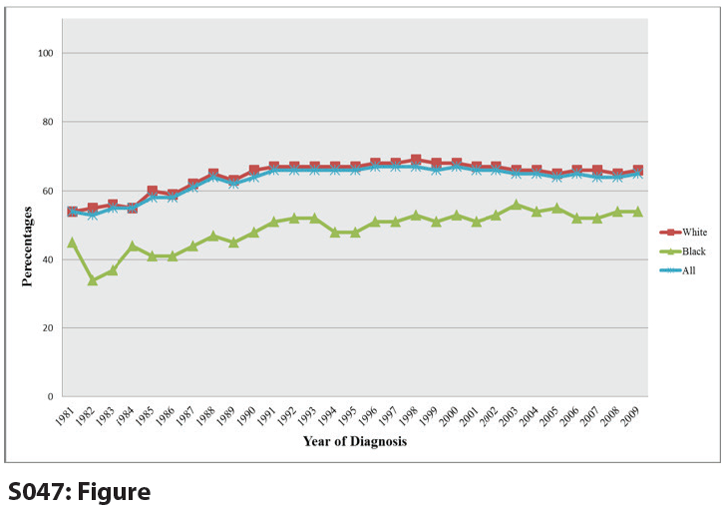(S047) Racial and Ethnic Differences in the Diagnosis of Breast Cancer: Changes in Presenting Stage in Minority Populations in Florida From 1981–2009
We examined whether presenting stage at time of breast cancer diagnosis has changed over time in Florida and whether there is variation in this change with respect to race, ethnicity, and socioeconomic status.
S047: Figure

Austin Dosch, BS, Margaret M. Byrne, PhD, Tulay Koru-Sengal, MS, Feng Miao, MS, Jean L. Wright, MD; University of Miami Miller School of Medicine
Background: Screening has led to a decrease in the number of women diagnosed with late-stage breast cancer, but there are limited studies assessing stage at diagnosis over time for black and Hispanic patients, who historically have been more likely to present with advanced disease. We examined whether presenting stage at time of breast cancer diagnosis has changed over time in Florida and whether there is variation in this change with respect to race, ethnicity, and socioeconomic status (SES).
Methods: Data were obtained from the Florida Cancer Data System (FCDS), which was linked with Florida’s Agency for Health Care Administration (AHCA) and with information from the US census track. Our sample included female breast cancer patients in Florida during 1981–2009 (n = 364,303). We excluded non-Florida residents aged < 18 years and with carcinoma in situ (n = 63,974). Patients with missing values for race, ethnicity, SES, or surgery (n = 73,678) were excluded, resulting in a total sample size of 226,651. Associations between categorical variables were examined using chi-square tests. Predictors of Surveillance, Epidemiology, and End Results (SEER) stage at diagnosis (local, regional, distant) were modeled with multinomial ordinal logistic regression models to obtain adjusted odds ratios (ORs) and corresponding 95% confidence intervals (95% CIs) for race, ethnicity, and SES. The model includes the year of diagnosis to take into account the trend over time for stage at diagnosis. Type I error rate was set at 5%. SAS v9.3 (SAS Institute Inc., Cary, NC) was used to perform all analyses.
Results: In total, 145,494 (64%) patients presented with local disease, 68,167 (30%) had regional disease, and 12,990 (6%) presented with distant disease. There were 206,994 (91%) white patients, 17,787 black patients (8%), and 1,920 (1%) of other races. A total of 207,311 (91%) were identified as non-Hispanic Latino, and 19,340 (9%) were Hispanic Latino. In the entire cohort, there was a significant increase in local disease and a decrease in regional and distant disease at presentation over the time period examined (P < .0001). The increase in local stage at diagnosis was greater for black than for white patients, as was the decrease in regional and distant disease (P < .001). Hispanic women also had a significant increase in localized disease and a decrease in regional and distant disease (P < .001), but there was little difference in the rate of change compared with non-Hispanic women. Multivariable analysis showed that race, ethnicity, and SES were all significantly associated with change in stage of diagnosis over time. Despite a greater rate of change for black patients, whites continued to have greater odds of local presentation (OR = 1.78; 95% CI, 1.69–1.88), and Hispanic patients continued to have lower odds of local presentation compared with non-Hispanic patients (OR = 0.80; 95% CI, 0.76–0.84).
Conclusions: Trends in Florida from 1981 to 2009 show that early-stage breast cancer diagnosis is more common over time in all race and ethnic groups. While there remains a significant disparity, with black and Hispanic patients being less likely to present with early-stage disease, the rate of change appears to be greater for black patients. Thus, this disparity may be decreasing over time, particularly for black patients.
Proceedings of the 96th Annual Meeting of the American Radium Society - americanradiumsociety.org
Newsletter
Stay up to date on recent advances in the multidisciplinary approach to cancer.